This is an old revision of this page, as edited by 50.35.38.102 (talk) at 02:14, 27 July 2018. The present address (URL) is a permanent link to this revision, which may differ significantly from the current revision.
Revision as of 02:14, 27 July 2018 by 50.35.38.102 (talk)(diff) ← Previous revision | Latest revision (diff) | Newer revision → (diff) "Stronghold", "Fortress", and "Fort" redirect here. For other uses, see Stronghold (disambiguation), Fortress (disambiguation), and Fort (disambiguation). Not to be confused with Food fortification or Fortified wine.| This article needs additional citations for verification. Please help improve this article by adding citations to reliable sources. Unsourced material may be challenged and removed. Find sources: "Fortification" – news · newspapers · books · scholar · JSTOR (January 2013) (Learn how and when to remove this message) |
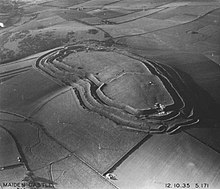
A fortification is a military construction or building designed for the defense of territories in warfare; and is also used to solidify rule in a region during peacetime. The term is derived from the Latin fortis ("strong") and facere ("to make").
From very early history to modern times, walls have often been necessary for cities to survive in an ever-changing world of invasion and conquest. Some settlements in the Indus Valley Civilization were the first small cities to be fortified. In ancient Greece, large stone walls had been built in Mycenaean Greece, such as the ancient site of Mycenae (famous for the huge stone blocks of its 'cyclopean' walls). A Greek phrourion was a fortified collection of buildings used as a military garrison, and is the equivalent of the Roman castellum or English fortress. These constructions mainly served the purpose of a watch tower, to guard certain roads, passes, and lands that might threaten the kingdom. Though smaller than a real fortress, they acted as a border guard rather than a real strongpoint to watch and maintain the border.
The art of setting out a military camp or constructing a fortification traditionally has been called "castramentation" since the time of the Roman legions. Fortification is usually divided into two branches: permanent fortification and field fortification. There is also an intermediate branch known as semi-permanent fortification. Castles are fortifications which are regarded as being distinct from the generic fort or fortress in that they are a residence of a monarch or noble and command a specific defensive territory.
Roman forts and hill forts were the main antecedents of castles in Europe, which emerged in the 9th century in the Carolingian Empire. The Early Middle Ages saw the creation of some towns built around castles.
Medieval-style fortifications were largely made obsolete by the arrival of cannons in the 14th century. Fortifications in the age of black powder evolved into much lower structures with greater use of ditches and earth ramparts that would absorb and disperse the energy of cannon fire. Walls exposed to direct cannon fire were very vulnerable, so the walls were sunk into ditches fronted by earth slopes to improve protection.
The arrival of explosive shells in the 19th century led to yet another stage in the evolution of fortification. Star forts did not fare well against the effects of high explosive, and the intricate arrangements of bastions, flanking batteries and the carefully constructed lines of fire for the defending cannon could be rapidly disrupted by explosive shells. Steel-and-concrete fortifications were common during the 19th and early 20th centuries. However the advances in modern warfare since World War I have made large-scale fortifications obsolete in most situations.
Demilitarized zones along borders are arguably another type of fortification, although a passive kind, providing a buffer between potentially hostile militaries.
Nomenclature
| This section does not cite any sources. Please help improve this section by adding citations to reliable sources. Unsourced material may be challenged and removed. (January 2013) (Learn how and when to remove this message) |
Many US military installations are known as forts, although they are not always fortified. Indeed, during the pioneering era of North America, many outposts on the frontiers, even non-military outposts, were referred to generically as forts. Larger military installations may be called fortresses; smaller ones were once known as fortalices. The word fortification can also refer to the practice of improving an area's defence with defensive works. City walls are fortifications but are not necessarily called fortresses.
The art of setting out a military camp or constructing a fortification traditionally has been called castramentation since the time of the Roman legions. The art/science of laying siege to a fortification and of destroying it is commonly called siegecraft or siege warfare and is formally known as poliorcetics. In some texts this latter term also applies to the art of building a fortification.
Fortification is usually divided into two branches: permanent fortification and field fortification. Permanent fortifications are erected at leisure, with all the resources that a state can supply of constructive and mechanical skill, and are built of enduring materials. Field fortifications—for example breastworks—and often known as fieldworks or earthworks, are extemporized by troops in the field, perhaps assisted by such local labour and tools as may be procurable and with materials that do not require much preparation, such as earth, brushwood and light timber, or sandbags (see sangar). An example of field fortification was the construction of Fort Necessity by George Washington in 1754.
There is also an intermediate branch known as semi-permanent fortification. This is employed when in the course of a campaign it becomes desirable to protect some locality with the best imitation of permanent defences that can be made in a short time, ample resources and skilled civilian labour being available. An example of this is the construction of Roman forts in England and in other Roman territories where camps were set up with the intention of staying for some time, but not permanently.
Castles are fortifications which are regarded as being distinct from the generic fort or fortress in that it describes a residence of a monarch or noble and commands a specific defensive territory. An example of this is the massive medieval castle of Carcassonne.
History
Ancient
From very early history to modern times, walls have been a necessity for many cities. In Bulgaria, near the town of Provadia a walled fortified settlement today called Solnitsata starting from 4700 BC had a diameter of about 300 feet (100 meters), was home to 350 people living in two-storey houses, and was encircled by a fortified wall. The huge walls around the settlement, which were built very tall and with stone blocks which are 6 feet (2 meters) high and 4.5 feet (1.5 meters) thick, make it one of the earliest walled settlements in Europe but it is younger than the walled town of Sesklo in Greece from 6800 BC. Uruk in ancient Sumer (Mesopotamia) is one of the world's oldest known walled cities. The Ancient Egyptians also built fortresses on the frontiers of the Nile Valley to protect against invaders from neighbouring territories. Many of the fortifications of the ancient world were built with mud brick, often leaving them no more than mounds of dirt for today's archaeologists.
A massive prehistoric stone wall surrounded the ancient temple of Ness of Brodgar 3200 BC in Scotland. Named the "Great Wall of Brodgar" it was four metres thick and four metres tall. The wall had some symbolic or ritualistic function. The Assyrians deployed large labour forces to build new palaces, temples and defensive walls.
Some settlements in the Indus Valley Civilization were also fortified. By about 3500 BC, hundreds of small farming villages dotted the Indus floodplain. Many of these settlements had fortifications and planned streets. The stone and mud brick houses of Kot Diji were clustered behind massive stone flood dykes and defensive walls, for neighbouring communities bickered constantly about the control of prime agricultural land. Mundigak (c. 2500 BC) in present-day south-east Afghanistan has defensive walls and square bastions of sun dried bricks.

In Bronze Age Malta, some settlements also began to be fortified. The most notable surviving example is Borġ in-Nadur, where a bastion built in around 1500 BC was found Babylon was one of the most famous cities of the ancient world, especially as a result of the building program of Nebuchadnezzar, who expanded the walls and built the Ishtar Gate. Exceptions were few—notably, ancient Sparta and ancient Rome did not have walls for a long time, choosing to rely on their militaries for defence instead. Initially, these fortifications were simple constructions of wood and earth, which were later replaced by mixed constructions of stones piled on top of each other without mortar. In ancient Greece, large stone walls had been built in Mycenaean Greece, such as the ancient site of Mycenae (famous for the huge stone blocks of its 'cyclopean' walls). In classical era Greece, the city of Athens built two parallel stone walls, called the Long Walls, that reached their fortified seaport at Piraeus a few miles away.
In Central Europe, the Celts built large fortified settlements known as oppida, whose walls seem partially influenced by those built in the Mediterranean. The fortifications were continuously being expanded and improved. Around 600 BC, in Heuneburg, Germany, forts were constructed with a limestone foundation supported by a mudbrick wall approximately 4 metres tall, probably topped by a roofed walkway, thus reaching a total height of 6 metres. The wall was clad with lime plaster, regularly renewed. Towers protruded outwards from it.

The Oppidum of Manching (German: Oppidum von Manching) was a large Celtic proto-urban or city-like settlement at modern-day Manching (near Ingolstadt), Bavaria (Germany). The settlement was founded in the 3rd century BC and existed until c. 50-30 BC. It reached its largest extent during the late La Tène period (late 2nd century BC), when it had a size of 380 hectares. At that time, 5,000 to 10,000 people lived within its 7.2 km long walls. The oppidum of Bibracte is another example of a Gaulish fortified settlement.
The Mura aureliane are a line of city walls built between 271 AD and 275 AD in Rome, Italy, during the reign of the Roman Emperors Aurelian and Probus. The walls enclosed all the seven hills of Rome plus the Campus Martius and, on the right bank of the Tiber, the Trastevere district. The river banks within the city limits appear to have been left unfortified, although they were fortified along the Campus Martius. The full circuit ran for 19 kilometres (12 mi) surrounding an area of 13.7 square kilometres (5.3 sq mi). The walls were constructed in brick-faced concrete, 3.5 metres (11 ft) thick and 8 metres (26 ft) high, with a square tower every 100 Roman feet (29.6 metres (97 ft)). In the 5th century, remodelling doubled the height of the walls to 16 metres (52 ft). By 500 AD, the circuit possessed 383 towers, 7,020 crenellations, 18 main gates, 5 postern gates, 116 latrines, and 2,066 large external windows.
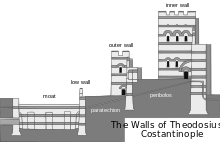
The Romans fortified their cities with massive, mortar-bound stone walls. The most famous of these are the largely extant Aurelian Walls of Rome and the Theodosian Walls of Constantinople, together with partial remains elsewhere. These are mostly city gates, like the Porta Nigra in Trier or Newport Arch in Lincoln. Hadrian's Wall was built by the Roman Empire across the width of what is now northern England following a visit by Roman Emperor Hadrian (AD 76–138) in AD 122.
India
Main article: List of forts in IndiaIndia has more forts than any other country in the world, which were built in all periods between the late stone age and the British Raj. "Fort" is the word used in India for all old fortifications. India currently has over 180 forts, with the state of Maharashtra alone having over 70 forts, which are also known as durg, many of them built by Shivaji, founder of the Maratha state. A large majority of forts in India are in North India. The most notable forts are the Red Fort at Delhi, the Red Fort at Agra, the Chittor Fort and Mehrangarh Fort in Rajasthan, the Ranthambhor Fort in Rajasthan and Gwalior Fort in Madhya Pradesh.
China
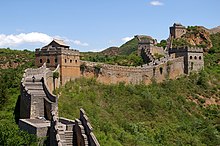
Large tempered earth (i.e. rammed earth) walls were built in ancient China since the Shang dynasty (c. 1600–1050 BC); the capital at ancient Ao had enormous walls built in this fashion (see siege for more info). Although stone walls were built in China during the Warring States (481–221 BC), mass conversion to stone architecture did not begin in earnest until the Tang dynasty (618–907 AD). The Great Wall of China had been built since the Qin dynasty (221–207 BC), although its present form was mostly an engineering feat and remodelling of the Ming dynasty (1368–1644 AD).
In addition to the Great Wall, a number of Chinese cities also employed the use of defensive walls to defend their cities. Notable Chinese city walls include the city walls of Hangzhou, Nanjing, the Old City of Shanghai, Suzhou, Xi'an and the walled villages of Hong Kong. The famous walls of the Forbidden City in Beijing were established in the early 15th century by the Yongle Emperor. The Forbidden City made up the inner portion of the Beijing city fortifications.
Philippines
Main articles: Ivatan people and Architecture of the PhilippinesThe Ivatan people of the northern islands of Batanes often built fortifications to protect themselves during times of war. They built their so-called idjangs on hills and elevated areas. These fortifications were likened to European castles because of their purpose. Usually, the only entrance to the castles would be via a rope ladder that would only be lowered for the villagers and could be kept away when invaders arrived.

The Igorots built forts made of stone walls that averaged several meters in width and about two to three times the width in height around 2000 BC.
With the arrival of Muslim scholars from nearby Indonesia, the native Filipinos were introduced to the concept of the Kota or fort. The Muslim Filipinos of the south built strong fortresses called kota or moong to protect their communities. Usually, many of the occupants of these kotas are entire families rather than just warriors. Lords often had their own kotas to assert their right to rule, it served not only as a military installation but as a palace for the local Lord. It is said that at the height of the Maguindanao Sultanate's power, they blanketed the areas around Western Mindanao with Kotas and other fortifications to block the Spanish advance into the region. These kotas were usually made of stone and bamboo or other light materials and surrounded by trench networks. As a result, some of these kotas were burned easily of destroyed. With further Spanish campaigns in the region, the Sultanate was subdued and majority of Kotas dismantled or destroyed. Kotas were not only used by the Muslims as defense against Spaniards and other foreigners, renegades and rebels also built fortifications in defiance of other chiefs in the area. During the American occupation, rebels built strongholds and the Datus, Rajahs or Sultans often built and reinforced their kotas in a desperate bid to maintain rule over their subjects and their land. Many of these forts were also destroyed by American expeditions, as a result, very very few kotas still stand to this day. Notable Kotas:
- Kota Selurong: an outpost of the Bruneian Empire in Luzon, later became the City of Manila.
- Kuta Wato/Kota Bato: Literally translates to "stone fort" the first known stone fortification in the country, its ruins exist as the "Kutawato Cave Complex"
- Kota Sug/Jolo: The capital and seat of the Sultanate of Sulu. When it was occupied by the Spaniards in the 1870s they converted the kota into the world's smallest walled city.
And during the Spanish Era, The Intramuros is the old walled city of Manila located along the southern bank of the Pasig River. The historic city was home to centuries-old churches, schools, convents, government buildings and residences, the best collection of Spanish colonial architecture before much of it was destroyed by the bombs of World War II. Of all the buildings within the 67-acre city, only one building, the San Agustin Church, survived the war.
Islamic

During Muhammad's era in Arabia, many tribes made use of fortifications. In the Battle of the Trench, the largely outnumbered defenders of Medina, mainly Muslims led by Islamic prophet Muhammad, dug a trench, which together with Medina's natural fortifications, rendered the confederate cavalry (consisting of horses and camels) useless, locking the two sides in a stalemate. Hoping to make several attacks at once, the confederates persuaded the Medina-allied Banu Qurayza to attack the city from the south. However, Muhammad's diplomacy derailed the negotiations, and broke up the confederacy against him. The well-organized defenders, the sinking of confederate morale, and poor weather conditions caused the siege to end in a fiasco.
During the Siege of Ta'if in January 630, Muhammad ordered his followers to attack enemies who fled from the Battle of Hunayn and sought refuge in the fortress of Taif.
Medieval Europe
Main article: Medieval fortification See also: Austrian walled townsRoman forts and hill forts were the main antecedents of castles in Europe, which emerged in the 9th century in the Carolingian Empire. The Early Middle Ages saw the creation of some towns built around castles. These cities were only rarely protected by simple stone walls and more usually by a combination of both walls and ditches. From the 12th century hundreds of settlements of all sizes were founded all across Europe, which very often obtained the right of fortification soon afterwards.
The founding of urban centres was an important means of territorial expansion and many cities, especially in eastern Europe, were founded precisely for this purpose during the period of Eastern Colonisation. These cities are easy to recognise due to their regular layout and large market spaces. The fortifications of these settlements were continuously improved to reflect the current level of military development.
During the Renaissance era, the Venetians raised great walls around cities threatened by the Ottoman Empire. The finest examples are, among others, in Nicosia (Cyprus) and Chania (Crete), which proved to be futile but still stand to this day.
Development after introduction of firearms
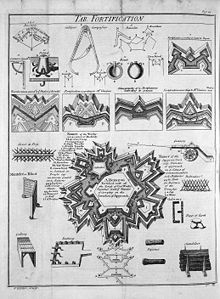
Medieval-style fortifications were largely made obsolete by the arrival of cannons on the 14th century battlefield. Fortifications in the age of black powder evolved into much lower structures with greater use of ditches and earth ramparts that would absorb and disperse the energy of cannon fire. Walls exposed to direct cannon fire were very vulnerable, so were sunk into ditches fronted by earth slopes.
This placed a heavy emphasis on the geometry of the fortification to allow defensive cannonry interlocking fields of fire to cover all approaches to the lower and thus more vulnerable walls.
The evolution of this new style of fortification can be seen in transitional forts such as Sarzanello in North West Italy which was built between 1492 and 1502. Sarzanello consists of both crenellated walls with towers typical of the medieval period but also has a ravelin like angular gun platform screening one of the curtain walls which is protected from flanking fire from the towers of the main part of the fort. Another example are the fortifications of Rhodes which were frozen at 1522 so that Rhodes is the only European walled town that still shows the transition between the classical medieval fortification and the modern ones.
Fortifications also extended in depth, with protected batteries for defensive cannonry, to allow them to engage attacking cannon to keep them at a distance and prevent them bearing directly on the vulnerable walls.
The result was star shaped fortifications with tier upon tier of hornworks and bastions, of which Fort Bourtange is an excellent example. There are also extensive fortifications from this era in the Nordic states and in Britain, the fortifications of Berwick-upon-Tweed and the harbour archipelago of Suomenlinna at Helsinki being fine examples.
19th century
The arrival of explosive shells in the 19th century led to yet another stage in the evolution of fortification. Star forts did not fare well against the effects of high explosive and the intricate arrangements of bastions, flanking batteries and the carefully constructed lines of fire for the defending cannon could be rapidly disrupted by explosive shells.

Worse, the large open ditches surrounding forts of this type were an integral part of the defensive scheme, as was the covered way at the edge of the counter scarp. The ditch was extremely vulnerable to bombardment with explosive shells.
In response, military engineers evolved the polygonal style of fortification. The ditch became deep and vertically sided, cut directly into the native rock or soil, laid out as a series of straight lines creating the central fortified area that gives this style of fortification its name.
Wide enough to be an impassable barrier for attacking troops, but narrow enough to be a difficult target for enemy shellfire, the ditch was swept by fire from defensive blockhouses set in the ditch as well as firing positions cut into the outer face of the ditch itself.
The profile of the fort became very low indeed, surrounded outside the ditch covered by caponiers by a gently sloping open area so as to eliminate possible cover for enemy forces, while the fort itself provided a minimal target for enemy fire. The entrypoint became a sunken gatehouse in the inner face of the ditch, reached by a curving ramp that gave access to the gate via a rolling bridge that could be withdrawn into the gatehouse.
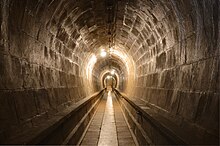
Much of the fort moved underground. Deep passages and tunnels now connected the blockhouses and firing points in the ditch to the fort proper, with magazines and machine rooms deep under the surface. The guns, however, were often mounted in open emplacements and protected only by a parapet; both in order to keep a lower profile and also because experience with guns in closed casemates had seen them put out of action by rubble as their own casemates were collapsed around them.
Gone were citadels surrounding towns: forts were to be moved to the outside of the cities some 12 km to keep the enemy at a distance so their artillery could not bombard the city center. From now on a ring of forts were to be built at a spacing that would allow them to effectively cover the intervals between them.
The new forts abandoned the principle of the bastion, which had also been made obsolete by advances in arms. The outline was a much simplified polygon, surrounded by a ditch. These forts, built in masonry and shaped stone, were designed to shelter their garrison against bombardment. One organizing feature of the new system involved the construction of two defensive curtains: an outer line of forts, backed by an inner ring or line at critical points of terrain or junctions (see, for example, Séré de Rivières system in France).
Traditional fortification however continued to be applied by European armies engaged in warfare in colonies established in Africa against lightly armed attackers from amongst the indigenous population. A relatively small number of defenders in a fort impervious to primitive weaponry could hold out against high odds, the only constraint being the supply of ammunition.
20th and 21st centuries
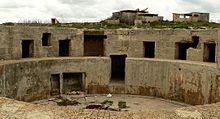
Steel-and-concrete fortifications were common during the 19th and early 20th centuries. However the advances in modern warfare since World War I have made large-scale fortifications obsolete in most situations. In the 1930s and 1940s, some fortifications were built with designs taking into consideration the new threat of aerial warfare, for example Fort Campbell in Malta. Despite this, only underground bunkers are still able to provide some protection in modern wars. Many historical fortifications were demolished during the modern age, but a considerable number survive as popular tourist destinations and prominent local landmarks today.
The downfall of permanent fortifications had two causes:
- The ever-escalating power, speed, and reach of artillery and air power meant that almost any target that could be located could be destroyed, if sufficient force were massed against it. As such, the more resources a defender devoted to reinforcing a fortification, the more combat power that fortification justified being devoted to destroying it, if the fortification's destruction was demanded by an attacker's strategy. From World War II, bunker busters were used against fortifications. By 1950, nuclear weapons were capable of destroying entire cities, and produced dangerous radiation. This led to the creation of civilian nuclear air raid shelters.
- The second weakness of permanent fortification was its very permanency. Because of this it was often easier to go around a fortification and, with the rise of mobile warfare in the beginning of World War II, this became a viable offensive choice. When a defensive line was too extensive to be entirely bypassed, massive offensive might could be massed against one part of the line allowing a breakthrough, after which the rest of the line could be bypassed. Such was the fate of the many defensive lines built before and during World War II, such as the Siegfried Line, the Stalin Line and the Atlantic Wall. This was not the case with the Maginot Line; it was designed to force the Germans to invade other countries (Belgium or Switzerland) to go around it, and was successful in that sense.

Instead field fortification rose to dominate defensive action. Unlike the trench warfare which dominated World War I, these defences were more temporary in nature. This was an advantage because since it was less extensive it formed a less obvious target for enemy force to be directed against.
If sufficient power were massed against one point to penetrate it, the forces based there could be withdrawn and the line could be re-established relatively quickly. Instead of a supposedly impenetrable defensive line, such fortifications emphasized defence in depth, so that as defenders were forced to pull back or were overrun, the lines of defenders behind them could take over the defence.
Because the mobile offensives practised by both sides usually focused on avoiding the strongest points of a defensive line, these defences were usually relatively thin and spread along the length of a line. The defence was usually not equally strong throughout however.
The strength of the defensive line in an area varied according to how rapidly an attacking force could progress in the terrain that was being defended—both the terrain the defensive line was built on and the ground behind it that an attacker might hope to break out into. This was both for reasons of the strategic value of the ground, and its defensive value.
This was possible because while offensive tactics were focused on mobility, so were defensive tactics. The dug in defences consisted primarily of infantry and antitank guns. Defending tanks and tank destroyers would be concentrated in mobile "Fire Brigades" behind the defensive line. If a major offensive was launched against a point in the line, mobile reinforcements would be sent to reinforce that part of the line that was in danger of failing.
Thus the defensive line could be relatively thin because the bulk of the fighting power of the defenders was not concentrated in the line itself but rather in the mobile reserves. A notable exception to this rule was seen in the defensive lines at the Battle of Kursk during World War II, where German forces deliberately attacked into the strongest part of the Soviet defences seeking to crush them utterly.
The terrain that was being defended was of primary importance because open terrain that tanks could move over quickly made possible rapid advances into the defenders' rear areas that were very dangerous to the defenders. Thus such terrain had to be defended at all cost.
In addition, since in theory the defensive line only had to hold out long enough for mobile reserves to reinforce it, terrain that did not permit rapid advance could be held more weakly because the enemy's advance into it would be slower, giving the defenders more time to reinforce that point in the line. For example, the battle of the Hurtgen Forest in Germany during the closing stages of World War II is an excellent example of how difficult terrain could be used to the defenders' advantage.
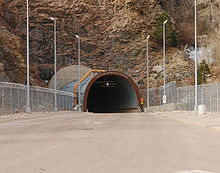
After World War II, ICBMs capable of reaching much of the way around the world were developed, and so speed became an essential characteristic of the strongest militaries and defenses. Missile silos were developed, so missiles could be fired from the middle of a country and hit cities and targets in another country, and airplanes (and air carriers) became major defenses and offensive weapons (leading to an expansion of the use of airports and airstrips as fortifications). Mobile defenses could be had underwater, too, in the form of nuclear submarines capable of firing missiles. Some bunkers in the mid to late 20th century came to be buried deep inside mountains and prominent rocks, such as Gibraltar and the Cheyenne Mountain Complex. On the ground itself, minefields have been used as hidden defences in modern warfare, often remaining long after the wars that have produced them have ended.
Demilitarized zones along borders are arguably another type of fortification, although a passive kind, providing a buffer between potentially hostile militaries.
Counter-insurgency
Just as in colonial periods, comparatively obsolete fortifications are still used for low-intensity conflicts. Such fortifications range in size from small patrol bases or forward operating bases up to huge airbases such as Camp Bastion/Leatherneck in Afghanistan. Much like in the 18th and 19th century, because the enemy is not a powerful military force with the heavy weaponry required to destroy fortifications, walls of gabion, sandbag or even simple mud can provide protection against small arms and anti-tank weapons - although such fortifications are still vulnerable to mortar and artillery fire.
Forts
Forts in modern usage often refer to space set aside by governments for a permanent military facility; these often do not have any actual fortifications, and can have specializations (military barracks, administration, medical facilities, or intelligence).
However, there are some modern fortifications that are referred to as forts. These are typically small semi permanent fortifications. In urban combat they are built by upgrading existing structures such as houses or public buildings. In field warfare they are often log, sandbag or gabion type construction.
Such forts are typically only used in low level conflict, such as counterinsurgency conflicts or very low level conventional conflicts, such as the Indonesia–Malaysia confrontation, which saw the use of log forts for use by forward platoons and companies. The reason for this is that static above ground forts can not survive modern direct or indirect fire weapons larger than mortars, RPGs and small arms.
North America
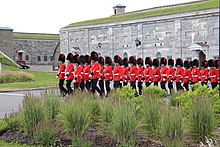
In the United States usage, forts specifically refer to US Army bases; US Marine Corps bases are referred to as camps. In Canada, forts were used by colonial militaries, the Canadian Militia, and various fur trading companies, most notably the Hudson Bay Company. While many forts in Canada have been converted in use (including historical museums), several forts in Canada continue to be used by Canadian Armed Forces, including Fort Frontenac (as the Canadian Army Command and Staff College). The Citadelle of Quebec, a citadel a part of the ramparts of Quebec City, is the largest citadel in North America still in use for military purposes.
In British North America, and subsequently on western frontier of the United States, prior to the 20th century the term fort was increasingly used for any military base of operations regardless of how fortified it was. Military forts in the American Old West during the Indian Wars were often lightly fortified enclosures, with log or adobe walls. In many areas the term fort was used to refer to any European or U.S. outpost, military, para-military, or civilian, that was located in an undeveloped region. Many of these outposts were simply a trading post, with a stockade and possibly blockhouses added, or a combination of a trading post and an Army post.
Prisons and others
Fortifications designed to keep the inhabitants of a facility in rather than out can also be found, in prisons, concentration camps, and other such facilities, with supermaxes having some of the strongest of those. Those are covered in other articles, as most prisons and concentration camps are not primarily military forts (although forts, camps, and garrison towns have been used as prisons and/or concentration camps; such as Theresienstadt, Guantanamo Bay detention camp and the Tower of London for example.
See also
- Border fence
- Castra
- Cavin
- Citadel
- Coastal fortification
- Defensive wall
- Hesco bastion
- Kuruwa, the walls of a Japanese castle
- List of fortifications
- List of forts
- Military camp
Fort components
- Abatis
- Banquette
- Barbed wire, Razor wire, Wire entanglement, and Wire obstacle
- Bartizan
- Bastion
- Berm
- Capital
- Caponier
- Casemate
- Curtain
- Czech hedgehog
- Defensive fighting position (aka a "foxhole")
- Ditch
- Embrasure
- Glacis
- Gun turret
- Keep
- Lunette
- Outwork
- Palisade
- Parapet
- Pillbox
- Postern
- Ravelin
- Revetment
- Sandbag
- Sangar
- Scarp and Counterscarp
- Turret
- Zwinger
Types of forts and fortification
- Blockhouse
- Bunker
- Castle
- Chinese city wall
- Compound
- Defensive wall
- Diaolou
- Fire support base
- Flak tower
- Fortress church or fortified church
- Grad, a Slavic wooden fortified settlement
- Gusuku, castles, forts, and fortifications in the Ryukyu Islands
- Korean fortress
- Hill fort
- Land battery
- Martello tower
- Medieval fortification
- Missile silo
- Pā a 19th-century Māori fortification
- Peel tower
- Polygonal fort
- Promontory fort
- Redoubt
- Stockade
- Star fort
Fortification and siege warfare
Famous experts
- Henri Alexis Brialmont
- César Cui
- Bernard de Gomme
- Francesco Laparelli
- Mozi
- Diades of Pella
- James of Saint George
- Fritz Todt
- Menno van Coehoorn
- Sébastien Le Prestre de Vauban
- Maximilian von Welsch
Notes
- "Bulgaria claims to find Europe's oldest town - Technology & science - Science | NBC News". MSNBC. 2012-11-01. Archived from the original on 2012-11-08. Retrieved 2013-05-04.
{{cite web}}: Unknown parameter|deadurl=ignored (|url-status=suggested) (help) - "BBC News - Europe's oldest prehistoric town unearthed in Bulgaria". Bbc.co.uk. 2012-10-31. Archived from the original on 2013-06-11. Retrieved 2013-05-04.
{{cite web}}: Unknown parameter|deadurl=ignored (|url-status=suggested) (help) - "Organization of neolithic settlements:house construction". Greek-thesaurus.gr. Archived from the original on 2013-07-22. Retrieved 2013-05-04.
{{cite web}}: Unknown parameter|deadurl=ignored (|url-status=suggested) (help) - "Hellenic Ministry of Culture and Tourism | Sesklo". Odysseus.culture.gr. Archived from the original on 2013-01-02. Retrieved 2013-05-04.
{{cite web}}: Unknown parameter|deadurl=ignored (|url-status=suggested) (help) - The Ness of Brodgar Excavations. "The Ness of Brodgar Excavations – The 'Great Wall of Brodgar'". Orkneyjar.com. Archived from the original on 2013-04-28. Retrieved 2013-05-04.
{{cite web}}: Unknown parameter|deadurl=ignored (|url-status=suggested) (help) - Alex Whitaker. "The Ness of Brodgar". Ancient-wisdom.co.uk. Archived from the original on 2013-05-01. Retrieved 2013-05-04.
{{cite web}}: Unknown parameter|deadurl=ignored (|url-status=suggested) (help) - Banister Fletcher's A History of Architecture By Banister Fletcher, Sir, Dan Cruickshank, Dan Cruickhank, Sir Banister Fletcher. Published 1996 Architectural Press. Architecture. 1696 pages. ISBN 0-7506-2267-9. pg no 20
- The Encyclopedia of World History: ancient, medieval, and modern, chronologically arranged By Peter N. Stearns, William Leonard Langer. Compiled by William L. Langer. Published 2001 Houghton Mifflin Books. History / General History. ISBN 0-395-65237-5. pg 17
- Banister Fletcher's A History of Architecture By Banister Fletcher, Sir, Dan Cruickshank, Dan Cruickhank, Sir Banister Fletcher. Published 1996 Architectural Press. Architecture. 1696 pages. ISBN 0-7506-2267-9. pg no 100
- Focke, Arne (2006). "Die Heuneburg an der oberen Donau: Die Siedlungsstrukturen". isentosamballerer.de (in German).
- "Erforschung und Geschichte der Heuneburg". Celtic Museum Heuneburg (in German). Archived from the original on 24 June 2007.
- Claridge, Amanda (1998). Rome: An Oxford Archaeological Guide, First, Oxford, UK: Oxford University Press, 1998, pp. 59, 332-335. ISBN 0-19-288003-9
- Durga is the Sanskrit word for "inaccessible place", hence "fort"
- {{Nossov, 2012, page=8}}
- Hiltebeitel, Alf (1991). The Cult of Draupadī: Mythologies: From Gingee to Kurukserta. Vol. 1. Delhi, India: Motilal Banarsidass. p. https://books.google.com/books?id=VncomfRVVhoC&pg=PA62 62]. ISBN 978-81-208-1000-6.
- Nossov, Konstantin (2012). Indian Castles 1206-1526: The Rise and Fall of the Delhi Sultanate (second ed.). Oxford, England: Osprey Publishing. p. 8. ISBN 978-1-78096-985-5.
- "15 Most Intense Archaeological Discoveries in Philippine History". FilipiKnow. Archived from the original on 15 March 2015. Retrieved 17 March 2015.
{{cite web}}: Unknown parameter|deadurl=ignored (|url-status=suggested) (help) - Ancient and Pre-Spanis Era of the Philippines Archived 2015-12-10 at the Wayback Machine. Accessed September 04, 2008.
- "Sultan of the River: The Rise and Fall of Datu Uto of Buayan". nhcpmanila's Blog. Archived from the original on 31 October 2014. Retrieved 17 March 2015.
{{cite web}}: Unknown parameter|deadurl=ignored (|url-status=suggested) (help) - "The Battle of Bayan - May 2 p2". Archived from the original on 30 December 2015. Retrieved 17 March 2015.
{{cite web}}: Unknown parameter|deadurl=ignored (|url-status=suggested) (help) - Administrator. "Where to Go - The KUTAWATO CAVES". Archived from the original on 16 October 2014. Retrieved 17 March 2015.
{{cite web}}: Unknown parameter|deadurl=ignored (|url-status=suggested) (help) - Luengo, Pedro. Intramuros: Arquitectura en Manila, 1739-1762. Madrid: Fundacion Universitaria Española, 2012
- *Watt, William M. (1974). Muhammad: Prophet and Statesman. Oxford University Press. p. 96. ISBN 0-19-881078-4.
- Mubarakpuri, Saifur Rahman Al (2005), The sealed nectar: biography of the Noble Prophet, Darussalam Publications, p. 481, ISBN 978-9960899558, archived from the original on 2016-04-19
{{citation}}: Unknown parameter|deadurl=ignored (|url-status=suggested) (help) Note: Shawwal 8AH is January 630AD - William Muir, The life of Mahomet and history of Islam to the era of the Hegira, Volume 4, p. 142.
- Harris, J., "Sarzana and Sarzanello - Transitional Design and Renaissance Designers" Archived 2011-07-26 at the Wayback Machine, Fort (Fortress Study Group), No. 37, 2009, pp. 50-78
- Medieval Town of Rhodes - Restoration Works (1985-2000) - Part One. Rhodes: Ministry of Culture – Works supervision committee for the monuments of the medieval town of Rhodes. 2001.
- Mifsud, Simon (14 September 2012). "Fort Campbell". MilitaryArchitecture.com. Archived from the original on 15 November 2015. Retrieved 15 March 2015.
{{cite web}}: Unknown parameter|deadurl=ignored (|url-status=suggested) (help)
References
 This article incorporates text from a publication now in the public domain: Chisholm, Hugh, ed. (1911). "Fortification and Siegecraft". Encyclopædia Britannica. Vol. 10 (11th ed.). Cambridge University Press. pp. 679–725.
This article incorporates text from a publication now in the public domain: Chisholm, Hugh, ed. (1911). "Fortification and Siegecraft". Encyclopædia Britannica. Vol. 10 (11th ed.). Cambridge University Press. pp. 679–725.
External links
| Stonemasonry | |
|---|---|
| Types | |
| Materials | |
| Tools | |
| Techniques | |
| Products | |
| Organizations | |